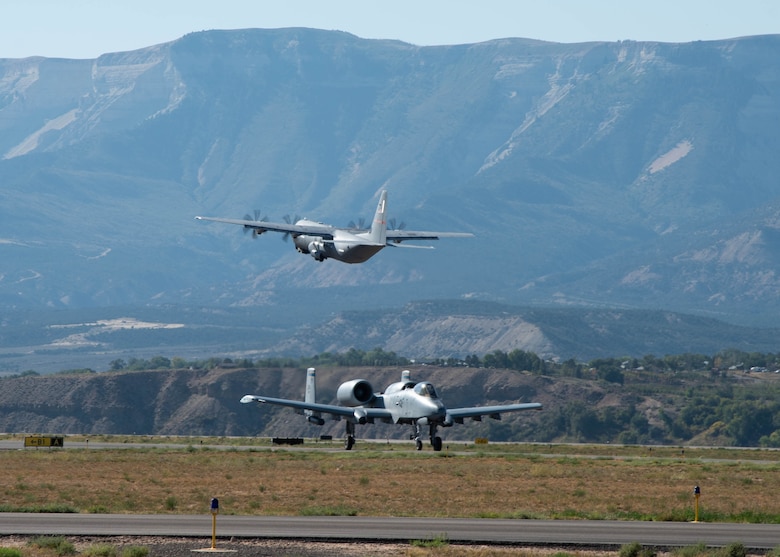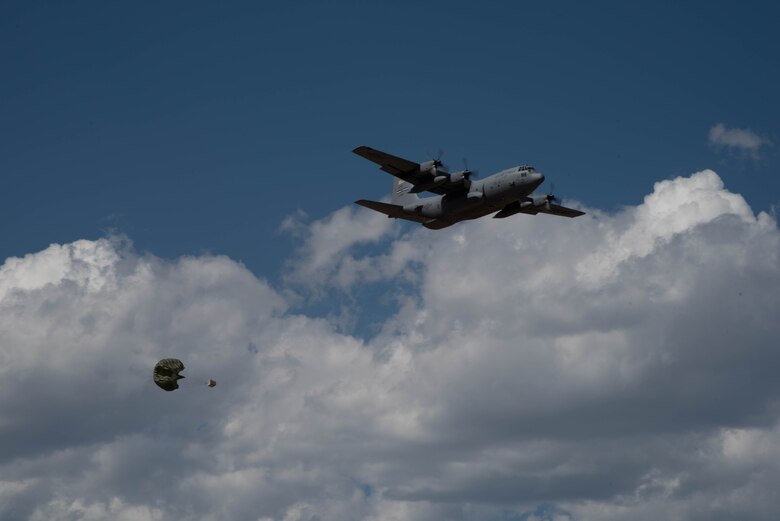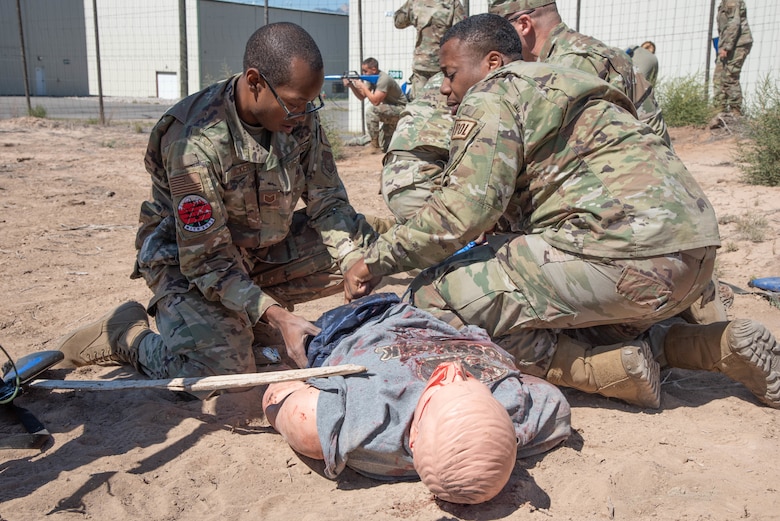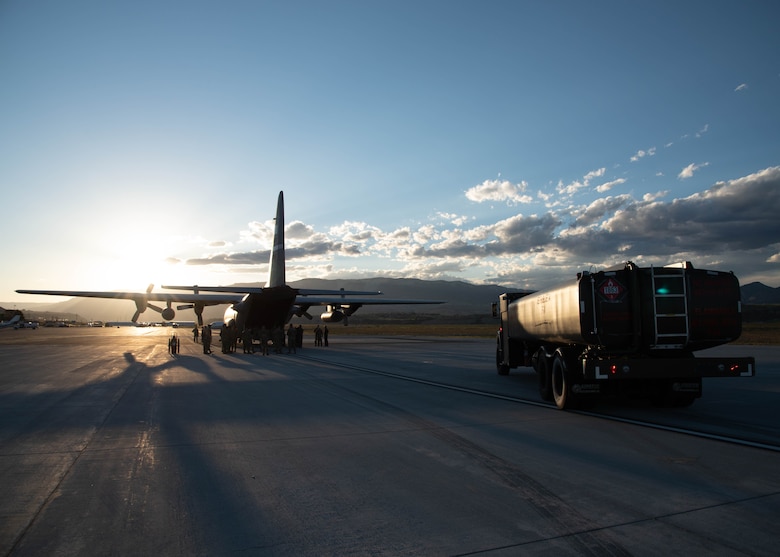Active duty, Air National Guard and Reserve Airmen gathered in Colorado and Wyoming for 22nd Air Force's flagship exercise Rally in the Rockies Sept. 12-17. The exercise is designed to develop Airmen for combat operations by challenging them with realistic scenarios that support a full spectrum of operations during military actions, operations or in hostile environments.
One of the three locations for the exercise was at the Rifle Garfield County Airport. More than 100 Airmen were in Rifle taking part in the air operations portion of the exercise and honing expeditionary skill sets by taking part in Multi-Capable Airmen training where they learned skills from various Air Force jobs to include wet-wing defueling and Tactical Combat Casualty Care.
"The exercise is designed to enhance our capabilities, such as Agile Combat Employment, deployment and Agile Combat Support," said Maj. Christopher Acs, 327th Airlift Squadron pilot with the Air Force Reserve's 913th Airlift Group at Little Rock Air Force Base, Arkansas, and the exercise planner and detachment commander at Rifle. "We are preparing Reserve and National Guard units to execute at the speed and range required to take on near-peer adversaries with a minimal footprint from austere environments to become more agile in mission execution and more resilient in our capability."
For the exercise, Rifle is a forward operating base, with dispersed operations from Peterson Space Force Base, Colorado, the Main Operating Base for the exercise. Four A-10 Thunderbolt IIs with the "Bulldogs," aka the 354th Fighter Squadron at Davis-Monthan Air Force Base, Arizona, were at Rifle as part of the exercise and C-130 Hercules flew in to support them.
When at a forward location, the goal is to operate with a small footprint, meaning operating with a small number of Airmen who need to be agile in their ability to carry out the mission. To prepare Airmen, the exercise also focused on Multi-Capable Airmen training.
"We are having Airmen learn capabilities outside their day-to-day jobs to help them take on future challenges they may encounter by increasing their readiness and expanding their war-fighting capabilities in an expeditionary environment," said Chief Master Sgt. Timothy Nugent, 22nd Air Force, Dobbins Air Reserve Base, Georgia, logistics planner and exercise lead for MCA training. "We have aerial porters, maintainers, security forces, and medical technicians doing things outside their career field and that's by design."
The Airmen learned a variety of skills to include wet-wing defueling, Tactical Combat Casualty Care, forklift driving, pallet build up and radio communication familiarization.
For most logistics readiness Airmen, or fuels technicians, it's out of the norm for them to wet-wing defuel. A wet-wing defuel procedure is used to quickly transfer fuel from one aircraft to another in forward operating bases where they don't have an established fuel storage facility. The aircraft lands, keeps engines running, and on-site ground crews transfer the fuel from the wing to a fuel truck. The fuel truck then transfers that fuel to another aircraft.
Staff Sgt. Ray Brown, a 403rd LRS fuels technician with the 403rd Wing at Keesler Air Force Base, Mississippi, has served for eight years and deployed to Southwest Asia for a year. It was his first exposure to the defueling process.
"It's always good to broaden your horizons in your career field and learn new things because you never know where you might deploy next and what situations you will encounter," he said.
One of those situations could be providing care to a fellow Airman while under fire. To prepare them for that scenario, Airmen were trained on TCCC, which focuses on care under fire, tactical field care and tactical evacuation care.
"The goal is to treat injured combatants and limit the risk of further casualties, so basically you are assessing a casualty and treating them in what can kill them first," said Staff Sgt. Lydia Neyra, 302nd Aeromedical Staging Squadron medical technician, 302nd Airlift Wing, Peterson SFB.
TCCC is framed around the MARCH concept in which Airmen look for and treat massive bleeding, check a patient's airway, respiratory status, circulation, and treat the patient for hypothermia or head injuries. Once the classroom portion of the training was complete, Airmen were tested on what they learned in a care under fire scenario, treating patients while securing an area, returning fire, and transporting casualties to a helicopter.
"It was an eye opening experience; you can watch training like this but to do this in person was a challenge as there was a lot going on and to think about--from taking care of the patient while getting shot at and knowing what you need to do next," said Tech. Sgt. Damon Lewis, a reservist who works in the 403rd Wing's 403rd Maintenance Squadron engine shop. "I'd like to do this more often so I can get more efficient at it."
Tech. Sgt. Robert Craciun, an avionics technician with the 910th Aircraft Maintenance Squadron, 910th Airlift Wing, Youngstown, Ohio, said he found the training extremely beneficial.
"In a real-world situation where we are deployed, being a mission-capable Airman and knowing about each other's jobs allows us to help each other out, making us more efficient. It was a very good learning experience, and all Airmen should have this type of training."
Units such as the 354th FS see the real-world value of the MCA concept, as they train to deploy in small maneuver units, smaller than a squadron, and operate from positions of advantage to attack the enemy.
"To maintain the same lethality with a smaller team, we need Airmen who can fill whatever role the team needs to execute the mission," said Maj. Pops O'Brien, 354th Fighter Squadron A-10 pilot and Dynamic Forward Adaptive Basing team lead. "Multi-capable Airmen equals a mission-capable attitude. We at the Bull Dogs greatly value the opportunity to foster relationships with other units at the leading edge of ACE."
"The training we get in exercises such as this is invaluable," Acs said. "We must arm our Airmen with the training, resources and equipment needed to engage in the high-end fight."

A C-130J Super Hercules flown by the 815th Airlift Squadron, Keesler Air Force Base, Mississippi, departs while an A-10 Thunderbolt II aircraft flown by the 354th Fighter Squadron, Davis-Monthan Air Force Base, Arizona, arrives at Rifle Garfiield County Airport, Colorado, Sept. 15, 2021. Active-duty Air Force, Air National Guard and Reserve Citizen Airmen gathered at the airfield to take part in the 22nd Air Force's flagship exercise Rally in the Rockies Sept. 12-17, 2021. The exercise is designed to develop Airmen for combat operations by challenging them with realistic scenarios that support a full spectrum of operations during military actions, operations or hostile environments. (U.S. Air Force photo by Lt. Col. Marnee A.C. Losurdo)

A C-130H Hercules aircraft with the 94th Airlift Wing, Dobbins Air Reserve Base, Georgia, drops cargo Sept. 14, 2021, at the Rifle Garfield County Airport, Colorado. Active-duty Air Force, Air National Guard and Reserve Citizen Airmen gathered at airfield to take part in the 22nd Air Force's flagship exercise Rally in the Rockies Sept. 12-17, 2021. The exercise is designed to develop Airmen for combat operations by challenging them with realistic scenarios that support a full spectrum of operations during military actions, operations or hostile environments. (U.S. Air Force photo by Lt. Col. Marnee A.C. Losurdo)

Tech. Sgt. Melvin Tucker, 403rd Logistics Readiness Squadron, Keesler Air Force Base, Mississippi, and Senior Airman Raymond Thomas, 910th LRS, Youngstown Air Reserve Base, Ohio, get hands on Tactical Combat Casualty Care training Sept. 15, 2021, at Rifle Garfield County Airport, Colorado during 22nd Air Force's flagship exercise Rally in the Rockies Sept. 12-17, 2021. The exericses is aimed at developing Airmen for combat operations. More than 100 Airmen were at Rifle Garfield County Airport, Rifle, Colorado taking part in the air operations portion of the exercise and honing expeditionary skill sets by taking part in Multi-Capable Airmen training where they learned skills from various Air Force jobs to include Wet-Wing Defueling and Tactical Combat Casualty Care. TCCC focuses on care under fire, tactical field care and tactical evacuation care. (U.S. Air Force photo by Lt. Col. Marnee A.C. Losurdo)

Active-duty Air Force, Air National Guard and Reserve Citizen Airmen who are fuel technicians and work in Logistics Readiness Squadrons, train on wet-wing defueling to offload fuel from a C-130J Super Hercules from the 403rd Wing, Keesler Air Force Base, Mississippi, Sept. 15, 2021, to a refueler truck. The Airmen gathered at Rifle-Garfield County Airport, Rifle, Colorado to take part in the 22nd Air Force's flagship exercise Rally in the Rockies Sept. 12-17, 2021. The exercise is designed to develop Airmen for combat operations by challenging them with realistic scenarios that support a full spectrum of operations during military actions, operations or hostile environments. (U.S. Air Force photo by Lt. Col. Marnee A.C. Losurdo)






